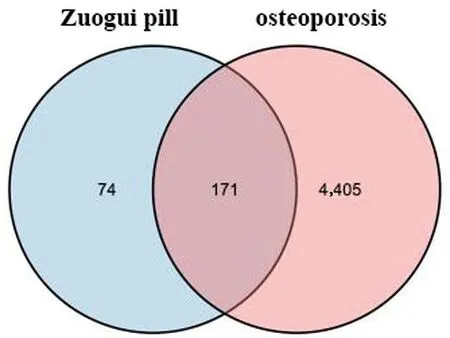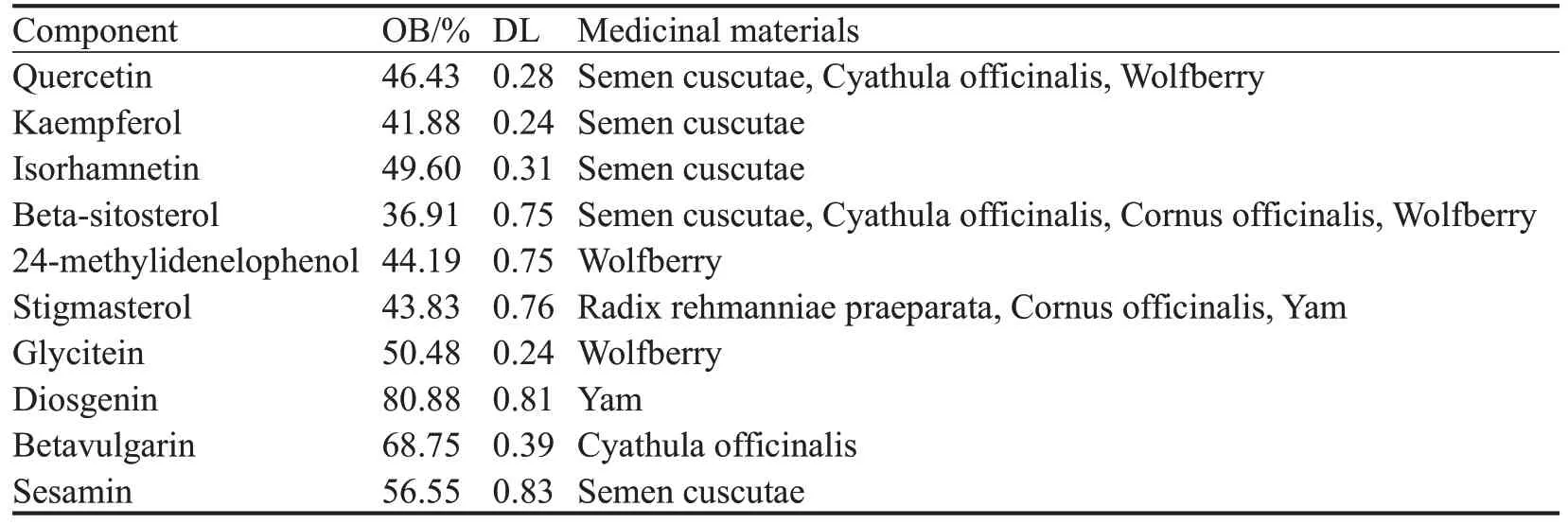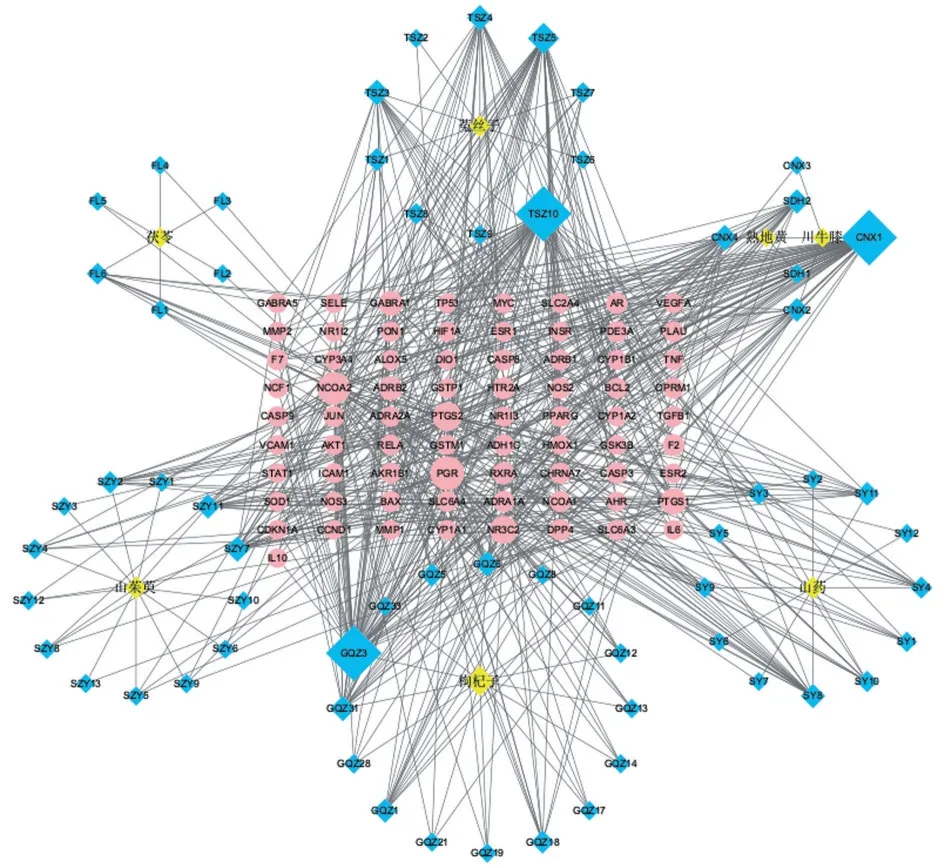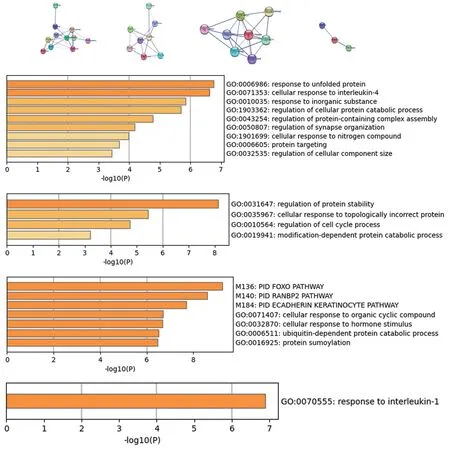Study on the mechanism of Zuogui pill in treating osteoporosis based on network pharmacology
Jing Li ,Liwei Wu ,Yang Xu,2 ,Chengxiang Xiao ,Bo Zhou*
Abstract Objective:To explore the effective active ingredients,targets and potential molecular mechanisms of Zuogui pill in the treatment of osteoporosis by means of network pharmacology.Methods:Using the TCMSP database to predict the active ingredients of Zuogui pill,and to screen out the potential active ingredients and targets.The disease target genes related to osteoporosis were retrieved from the GeneCards database.After screening through the Drugbank and Uniprot databases,the Zuogui pill-osteoporosis disease intersection genes were finally obtained.Cytoscape 3.8.2 software was used to construct a drug component-disease network diagram,and the intersection genes were used to construct a protein interaction network,and the core network and core target genes of Zuogui pill treatment for osteoporosis were obtained,and the core target genes were analyzed by using MCODE and Metascape databases.GO bio-enrichment analysis and KEGG pathway analysis were performed on the relevant targets through the Metascape database.Finally,cell experiments were used to further verify the effects of Zuogui pill on osteoclasts in vitro.Results: A total of 245 effective targets of Zuogui Pill and 4,576 targets of osteoporosis-related diseases are predicted,and there are 171 common targets.The active ingredients with higher moderate values are quercetin,kaempferol,isorhamnetin,β-sitosterol,and 24-methylenephenol.The core genes in the PPI network are APP,NTRK1,EGFR,CUL3,and HSP90AA1.GO enrichment analysis involves DNA binding transcription factor binding,RNA polymerase II specific DNA binding transcription factor binding and nuclear receptor activity;KEGG pathway enrichment analysis results show that the common targets can pass through the AGE-RAGE signaling pathway,TNF signaling pathway,IL-17 signal pathway,HIF-1 signal pathway and many other signal pathways.The cell experiments show that Zuogui pill could inhibit the formation of osteoclasts In vitro.Conclusion:Zuogui pill may play a role in the prevention and treatment of osteoporosis by inhibiting osteoclast formation,providing a new thinking route and method for followup basic experimental research.
Keywords Zuogui pill;osteoporosis;network pharmacology
Introduction
Osteoporosis is a systemic metabolic bone disease,which is characterized by decreased bone mineral density and bone quality,bone microstructure degeneration,resulting in increased bone fragility and the risk of fracture [1].Osteoporosis is often not detected until the onset of the disease,and the early clinical symptoms are not easy to observe,which is called"silent disease".With the increasing speed of population aging in China,the incidence of osteoporosis has leapt to the third place of chronic diseases in the world,which has become an urgent public health problem in China and even the whole world [2].At present,the main clinical drugs for the treatment of osteoporosis are vitamin D,parathyroid hormone,raloxifene and bisphosphate [3].However,the therapeutic effect of these drugs is not ideal because of the long course of treatment and obvious side effects,for example,bisphosphate can lead to osteonecrosis of the jaw and esophageal stimulus;and raloxifene can cause thromboembolic disease [4].Zuogui pill comes from Volume 51 of Jingyue Encyclopedia.As a tonic,Zuogui pill has the effect of strengthening kidneys,and cultivating the Yuanyin of the left kidney.This traditional Chinese medicine prescription is composed of Cyathula officinalis,Poria cocos,Chinese wolfberry,yam,Cornus officinalis,Radix rehmanniae praeparata and Semen cuscutae.The pharmacological effects of its components are reflected in many diseases,and some studies have shown that Zuogui pill has the effects of nourishing yin and tonifying kidney,supplementing body essence and marrow [5].In this study,network pharmacology was used to identify and predict the active components,targets and signaling pathways of the prescription for the treatment of osteoporosis,so as to provide guidance for the prevention and treatment of osteoporosis in the future.
Materials and methods
Screening of potential active components and targets of Zuogui pill
The active components of Cyathula officinalis,Poria cocos,Chinese wolfberry,yam,Cornus officinalis,Radix rehmanniae praeparata and Semen cuscutae in Zuogui pill were searched by Traditional Chinese Medicine System Pharmacology Database and Analysis Platform TCMSP (http://lsp.nwu.edu.cn/tcmsp.php,2021-8-13)[6].According to the pharmacokinetic of traditional Chinese medicine components (ADME),only when the oral bioavailability (OB) ≥30%and drug-like properties (DL) ≥0.18 were met at the same time,the potential targets were finally collected.Finally,the target gene names were regulated by Uni-Prot protein information database (https://www.uniprot.org/,2021-8-13)and DrugBank database(https://go.drugbank.com/,2021-8-13).
Screening of related targets for osteoporotic diseases
The Genecard human molecular query database(https://www.genecards.org/,2021-8-13) was used to obtain the targets related to the potential action of osteoporosis disease with "osteoporosis" as the keyword.After deleting the duplicates,the intersection was constructed in Xiantao website (https://www.xiantao.love/,2021-8-13),and the visual Wayne diagram of osteoporosis-Zuogui pill was obtained.
Construction of target network of Zuogui pill in the treatment of osteoporosis
The possible targets of Zuogui pill in the treatment of osteoporosis were selected to build a visual network in Cytoscape 3.8.2 software.The number of lines was proportional to the correlation degree,and the number of potential targets connected by the active components of effective drugs was proportional to the size of the nodes.
Construction of PPI network
The above drug action targets and disease targets were introduced into Cytoscape3.8.2,and the Protein-Protein Interaction (PPI) between drug target protein and disease target protein was constructed by Bisogenet plug-in,and the intersection PPI network was obtained.Then the CytoNCA plug-in was used to analyze the topology of the intersection PPI network data,and the core target network was obtained according to the node degree value screening processing.
Extraction of key modules of protein-protein interaction
The key target network was analyzed by MCODE plug-in in Cytoscape 3.8.2,and the key protein modules were extracted.The key protein modules were analyzed and plotted by String database (https://www.string-db.org/,2021-8-14) [7],and then imported into Cytoscape 3.8.2.The corresponding molecular function was analyzed by Metascape,and finally the possible signaling pathways were obtained.
Bio-enrichment and pathway analysis of common targets
The intersection gene was introduced into Metascape database (https://metascape.org/,2021-8-15) [8],and the species information selected "Homo sapiens".GO bio-enrichment analysis and KEGG pathway enrichment analysis were carried out.Finally,the enrichment bubble chart was obtained online by bioinformatics(http://www.bioinformatics.com.cn/,2021-8-15).
Verification of cell experiment in vitro
Bone marrow-derived macrophages (BMMs) were extracted from 6-week-old C57BL6/J mice (Animal Center of Guangxi Medical University);α-MEM,fetal bovine serum (FBS) and penicillin-streptomycin solution were purchased from Gibco.The RANKL and M-CSF needed for osteoclast culture were purchased from PeproTech EC.Zuogui pill was purchased from Zhongjing Wanxi Pharmaceutical Co.,Ltd.After crushed,the pills were completely dissolved into mother solution with dimethyl sulfoxide(DMSO),stored at-20 ℃for a long time,and then diluted into the required working solution by PBS.BMMs was inoculated and cultured in 96-well plate.The cells in the control group were stimulated by MCSF and RANKL (50 ng/mL).In the experimental group,different concentrations (5 μmol/L,10 μmol/L,20 μmol/L)of Zuogui pill were added,and the culture medium was changed every 48 hours until mature osteoclasts were observed in the control group.After being fixed for 30 min,the enzyme activity was observed by tartrate-resistant acid phosphatase (TRAP)staining.Finally,using BioTek imaging,the cells with more than 3 nuclei were counted as osteoclasts and quantitatively analyzed by Image J 1.53 software.
Results
Target of Zuogui pill
Seven components of Zuogui pill was searched by TCMSP database,and the screening conditions were set as oral bioavailability (OB≥30%) and drug-like drugs (DL≥0.18),113 active components were obtained.The target information of these active components was searched in DrugBank and Uniprot database at the same time,and the duplicates and invalid targets were deleted,and 245 targets of Zuogui pill were obtained.
Related targets of Zuogui pill in the treatment of osteoporosis
A total of 4,576 disease-related targets were obtained by searching the keyword "osteoporosis" in Genecard database and imported into DrugBank and Uniprot databases to delete duplicates and invalid targets.Finally,the Wayne diagram of Zuogui pill-osteoporosis targets with 171 overlapping genes was drawn online on Xiantao website(Figure 1).

Figure 1 Wayne diagram of Zuogui pill-osteoporosis target.
Visual network of active component target of Zuogui pill
The information of seven components and their corresponding targets of Zuogui pill were imported into Cytoscape 3.8.2 software to build a visual network of active components of Zuogui pill (Figure 2).The median value of the Degree value of the active component was used as the screening condition,and the node area of the active component with higher Degree value in the network was larger.Yellow represents the drug ingredient,blue represents the active ingredient of Zuogui pill,and pink represents the target gene of its action.According to the descending order of Degree value,the top 10 active components were mainly quercetin,kaempferol,isorhamnetin,beta-sitosterol,24-methylidenelophenol,Stigmasterol,glycitein,diosgenin,Betavulgarin and sesamin(Table 1).

Table 1 Top 10 active components of Zuogui Pill.
PPI network construction and core target of Zuogui pill in the treatment of osteoporosis
In the Cytoscape 3.8.2 software,the BisoGenet plugin was used to construct the PPI network of Zuogui pill-osteoporosis intersection gene target.Finally,7,285 nodes and 164,933 protein relationships were obtained.The first round of screening was conducted according to the double median Degree value,between centrality (BC) value,and closeness centrality(CC) value.Then the second round of screening was carried out according to the Degree value of double median,BC and the double median of CC,and finally the core target network was obtained,with 35 nodes and 334 lines of protein relationship,as shown in Figure 3.The top 5 core targets were amyloid precursor protein (APP),neurotrophin receptor tyrosine kinase(1NTRK1),epidermal growth factor receptor (EGFR),ubiquitin ligase Cullin 3 (CUL3) and 90 kDa heat shock protein αA1(HSP90AA1).

Figure 2 Drug ingredient-active ingredient-gene target network.
Extraction of key protein modules of Zuogui pill in the treatment of osteoporosis network
The MCODE algorithm was used to analyze the core target network,and 4 protein aggregation modules with the highest score were selected,and the gene ontology GO molecular function analysis was carried out through the Metascape database,the invalid connections were removed,and finally the signaling pathways that may be involved were obtained,as shown in Figure 4.
Bio-enrichment analysis and KEGG pathway enrichment analysis of common targets
The list of overlapping genes was imported into Metascape database,and the required bio-enrichment analysis report can be obtained by selecting anthropogenic species for direct analysis.The analysis included biological process (BP),cellular component (CC)and molecular function (MF) of the core target.The reported results were arranged according to Gene ratio,Pvalue and count values,genes were submitted online in bioinformatics,and the first 10 items were selected to calculate the enrichment,and then the bubble diagram was obtained,as shown in Figure 5.Biological processes mainly involved reactions to inorganic substances,cells to organic cyclic compounds,injury reactions,drug reactions,etc.The cellular components were mainly membrane raft,membrane microdomains,vesicle cavity,plasma membrane raft,fovea and so on.The molecular functions were mainly DNA binding transcription factor binding,RNA polymerase II specific DNA binding transcription factor binding,nuclear receptor activity,ligand-activated transcription factor activity and so on.Similarly,KEGG pathway enrichment analysis also screened the first 20 key pathways with high correlation,including cancer pathway,AGE-RAGE signaling pathway,TNF signaling pathway,IL-17 signaling pathway,HIF-1 signaling pathway and so on.
Effects of Zuogui pill on osteoclast differentiation
In order to observe the effect of Zuogui pill on osteoclast differentiation,we cultured the extracted BMMs with 50 ng/mL RANKL and different concentrations of Zuogui pill(5 μmol/L,10 μmol/L,20 μmol/L).After 7 days,until more mature multinucleated osteoclasts were observed in the control group (0 μmol/L Zuogui pill) treated with only RANKL,the cells were fixed and further stained to detect the activity of TRAP.Compared with the control group,Zuogui pill reduced the number of TRAP-positive osteoclast in a dose-dependent manner(Figure 6).

Figure 3 PPI network and core target map of Zuogui pill in the treatment of osteoporosis.

Figure 4 Key module diagram and molecular function analysis diagram of core network of Zuogui pill in the treatment of osteoporosis.

Figure 6 Effects of Zuogui pill on osteoclast differentiation.**P<0.05,***P<0.01 vs.Control group.
Discussion
Bone remodeling is a complex and ever-changing metabolic process,which removes old bone and produces new bone in order to achieve the dynamic balance of bone remodeling[9].Once the bone metabolism is imbalance dynamically,the ability of bone nutrient absorption and bone formation decreases,which will eventually lead to lytic osteopathy,such as osteoporosis [10].At present,the effect of drugs in the treatment of osteoporosis is not well-responded,but in traditional Chinese medicine,it is considered that the kidney mainly produces bone marrow [11].Zuogui pill is the first prescription of strengthening kidneys,now it is mainly used to treat lumbago caused by renal insufficiency [12],spermatorrhea,hypertension[13],chronic nephritis and so on.The molecular mechanism of this traditional Chinese medicine prescription on osteoporosis has not been reported.
The results of this study showed that a total of 113 potentially active components of Zuogui pill meeting the requirements of OB ≥30% and DL ≥0.18 were screened by TCMSP database,and 171 drug-disease targets were obtained by intersecting the joint action targets of Zuogui pill and osteoporosis.By analyzing the network diagram,it was found that the components with higher Degree value of active components included quercetin,kaempferol,isorhamnetin,β-sitosterol,24-methylene phenol and so on.Recent studies have shown that quercetin,as a flavonol has pharmacological effects such as antibacterial,anti-inflammatory,anti-allergic,anti-cancer,anti-free radical,protection of cardiovascular function and so on [14].Quercetin can significantly improve the number and structure of bone trabeculae by inhibiting ERK1/2-MAPK signaling pathway,and it can also improve osteoporosis in ovariectomized mice [15].Kaempferol has the functions of protecting injured cells,anti-cancer and treating diabetes.It can regulate the metabolic balance of Ca2+,reduce trabecular bone loss,promote the formation of bone collagen,and then prevent osteoporosis [16].Isorhamnetin is a flavonoid monomer isolated from hippophae rhamnoides and ginkgo.Isorhamnetin can inhibit platelet aggregation,resist hypoxia and improve hemodynamics.Studies have shown that isorhamnetin can inhibit the expression of NFATc1 by inhibiting RANKL/RANK/NF-κB signaling pathway and play an anti-osteoporosis effect[17].As the key targets for the treatment of osteoporosis,APP,NTRK1,EGFR,CUL3 and HSP90AA1 were obtained by PPI protein interaction network analysis.APP is a single-channel transmembrane protein,which can participate in apoptosis,iron metabolism and maintain intracellular homeostasis,and play a role in breast cancer,prostate cancer,bladder cancer and other cancers.The enrichment results of KEGG pathway showed that AGE-RAGE signal pathway was the most enriched pathway after cancer pathway.As a molecule promoting apoptosis,AGE played a role in aging and degenerative diseases.It is reported that AGE can inhibit the proliferation of MSCs,and inhibit the proliferation and differentiation of osteoblasts by promoting the release of reactive oxygen[18].The data show that reactive oxygen has been considered as the second messenger to regulate the activity of osteoclasts [19].A large number of reactive oxygen can activate bone absorption,which leads to the occurrence of osteoporosis.AGE also easily affects type I collagen,destroys the integrity of bone matrix proteins,and affects the process of bone remodeling[20].AGE binds to its receptor RAGE to activate a variety of intracellular signaling cascades,such as Janus kinase/signal transducer and activator of transcription (JAK/STAT),extracellular signal-regulated white kinase (ERK),c-jun N-terminal kinase(JNK),p38 mitogen-activated protein kinase (p38)pathway and NF-κB pathway [21].MAPK pathway and NF-κB pathway are two classic osteoclast pathways,which are closely related to osteoclast differentiation induced by RANKL[22].They affect osteoporosis by inhibiting the activity of NFATc1 and reducing osteoclast formation.NF-κB pathway is the key pathway to regulate cell autophagy [23].When the body is in aging,the level of autophagy decreases accordingly,NF-κB pathway can inhibit the bone resorption of osteoclasts to some extent,but at the same time,the autophagy of osteoblasts is also inhibited and new bone formation is also reduced.In addition,the combination of AGE and RAGE will also promote oxidative stress,further promote autophagy,so that bone resorption is much larger than bone formation,leading to osteoporosis.
To sum up,this study preliminarily revealed the possible molecular mechanism of Zuogui pill in the treatment of osteoporosis through the method of network pharmacology.The main mechanism is to interfere with the pathogenesis of osteoporosis by affecting the expression of key genes APP,NTRK1,EGFR,CUL3 and HSP90AA1,involving multiple pathways such as AGE-RAGE signaling pathway,TNF signaling pathway,IL-17 signaling pathway and HIF-1 signaling pathway,and playing the role of anti-inflammation and anti-apoptosis.It is consistent with the relevant animal experimental research reports.In conclusion,the results of this study are scientific and reliable to some extent,but the results are only a preliminary prediction of the anti-osteoporosis target and its possible mechanism of Zuogui pill.It is necessary to carry out a series of experiments to verify,so as to lay the foundation of a first-line drug for Zuogui pill to prevent osteoporosis.
AcknowledgmentsThis study was funded by National Natural Science Foundation of China (No.81860655)
 廣西醫(yī)科大學(xué)學(xué)報(bào)2021年12期
廣西醫(yī)科大學(xué)學(xué)報(bào)2021年12期
- 廣西醫(yī)科大學(xué)學(xué)報(bào)的其它文章
- 弗林蛋白酶的研究進(jìn)展*
- 重組Klotho蛋白對(duì)骨髓來(lái)源M1型巨噬細(xì)胞向M2型巨噬細(xì)胞轉(zhuǎn)變的影響*
- Let-7b-5p靶向ETFA減輕高磷誘導(dǎo)的血管平滑肌細(xì)胞鈣化的機(jī)制研究*
- 人血清新miRNA分子的預(yù)測(cè)及表達(dá)分析*
- 2021年廣西高等教育自治區(qū)級(jí)教學(xué)成果特等獎(jiǎng)廣西醫(yī)科大學(xué)藥學(xué)院《以學(xué)生發(fā)展為中心的“三位一體”立體化藥學(xué)人才培養(yǎng)體系創(chuàng)新與實(shí)踐》成果簡(jiǎn)介
- 山楂葉總黃酮對(duì)脊髓損傷后大鼠的作用研究*
